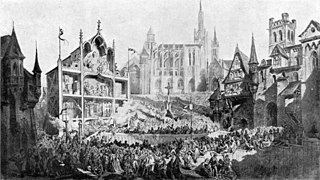
Halloween, or Hallowe'en, is a celebration observed in many countries on 31 October, the eve of the Western Christian feast of All Hallows' Day. It is at the beginning of the observance of Allhallowtide, the time in the liturgical year dedicated to remembering the dead, including saints (hallows), martyrs, and all the faithful departed. In popular culture, the day has become a celebration of horror and is associated with the macabre and the supernatural.

Mystery plays and miracle plays are among the earliest formally developed plays in medieval Europe. Medieval mystery plays focused on the representation of Bible stories in churches as tableaux with accompanying antiphonal song. They told of subjects such as the Creation, Adam and Eve, the murder of Abel, and the Last Judgment. Often they were performed together in cycles which could last for days. The name derives from mystery used in its sense of miracle, but an occasionally quoted derivation is from ministerium, meaning craft, and so the 'mysteries' or plays performed by the craft guilds.

Carnival or Shrovetide is a festive season that occurs at the close of the Christian pre-Lenten period, consisting of Quinquagesima or Shrove Sunday, Shrove Monday, and Shrove Tuesday or Mardi Gras.

Midsummer is a celebration of the season of summer, taking place on or near the date of the summer solstice in the Northern Hemisphere; the longest day of the year. The name "midsummer" mainly refers to summer solstice festivals of European origin. In these cultures it is traditionally regarded as the middle of summer, with the season beginning on May Day. Although the summer solstice falls on 20, 21 or 22 June in the Northern Hemisphere, it was traditionally reckoned to fall on 23–24 June in much of Europe. These dates were Christianized as Saint John's Eve and Saint John's Day. It is usually celebrated with outdoor gatherings that include bonfires and feasting.

The Lord Mayor's Show is one of the best-known annual events in London as well as one of the longest-established, dating back to the 13th century. A new lord mayor is appointed every year, and the public parade that takes place as their inauguration ceremony reflects that this was once one of the most prominent offices in England and subsequently the United Kingdom.

Processional giants are costumed figures in European folklore, particularly present in Belgian, French, Portuguese, Spanish, and English folkloric processions. The main feature of these figures is typically their wooden, papier maché or -more recently- synthetic resin head, whilst bodies are covered in clothing matching the costume's theme.

Saint John's Eve, starting at sunset on 23 June, is the eve of the feast day of Saint John the Baptist. This is one of the very few feast days marking a saint's birth, rather than their death. The Gospel of Luke states that John was born six months before Jesus; therefore, the feast of John the Baptist was fixed on 24 June, six months before Christmas. In the Roman calendar, 24 June was the date of the summer solstice, and Saint John's Eve is closely associated with Midsummer festivities in Europe. Traditions are similar to those of May Day and include bonfires, feasting, processions, church services, and gathering wild plants.

A procession is an organized body of people walking in a formal or ceremonial manner.
The Bendigo Easter Festival, also known as the Bendigo Easter Fair, is an annual event held in Bendigo, Victoria, Australia, since 1871 with the exception of 2020 and 2021 due to the COVID-19 pandemic. The festival includes the Easter procession which sees Dai Gum Loong, the world's longest imperial dragon, dance through the streets along with An extensive program of activities and attractions such as an Easter Egg hunt.

Golowan is the Cornish language word for the Midsummer celebrations in Cornwall, UK; they were widespread prior to the late 19th century and most popular in the Penwith area and in particular in Penzance. The celebrations began on St John's Eve with bonfires, fireworks, dancing and music, followed by a fair around the town quay on Midsummer Day and were repeated on St Peter's Eve and St Peter's Day.

The carnival in Colombia was introduced by the Spaniards. The Colombian carnival has incorporated elements from European culture, and has managed to syncretise, or re-interpret, traditions that belonged to the African and Amerindian cultures of Colombia. There is documentary evidence that the carnival existed in Colombia in the 17th century and had already caused concern to the colonial authorities, who censored the celebrations, especially in the main centers of power such as Cartagena, Bogotá and Popayán. The carnival, therefore, continued its evolution and re-interpretation in the small and at that time unimportant towns where celebrations did not offend the ruling elites. The result was the uninterrupted celebration of carnival festivals in Barranquilla, and other villages along the lower Magdalena River in northern Colombia, and in Pasto, Nariño in the south of the country. In modern times, there have been attempts to introduce the carnival in the capital, Bogotá, in the early 20th century, but it has always failed to gain the approval of authorities. The Bogotá Carnival has had to wait until the 21st century to be resurrected, this time, by the authorities of the city. Colombia is recognized by its large variety of festivals, carnivals and fairs. Most towns have their own, ranging from those celebrating coffee to the ones held in honor of the town's Saint feast. The common characteristics of the festivals are the nomination of a beauty Queen and the setting up of public dance floor.

Dragon Ball: Sleeping Princess in Devil's Castle is a 1987 Japanese animated fantasy martial arts adventure film and the second anime feature film based on the Dragon Ball manga by Akira Toriyama. It was originally released in Japan on July 18 at the "Toei Manga Matsuri" film festival as part of a quadruple feature along with the first Saint Seiya film and the film versions of Hikari Sentai Maskman and Choujinki Metalder. An English dub by Funimation was released in 1998. It was preceded by Dragon Ball: Curse of the Blood Rubies and followed by Dragon Ball: Mystical Adventure.
The Bower is a festival held each spring on a bank holiday in Lichfield, England. A statute of Henry II of England ordered that all men capable of bearing arms should be inspected by the magistrates. Since there was no standing army, this was a way to find out how many men could fight in a war. The men would then march through the streets and retire at a "Bower House" for roast beef and spirits, ensuring a good turn-out.

Ommegang or Ommeganck is the generic name for various medieval pageants celebrated in the Low Countries.

Riosucio is a town and municipality in the department of Caldas in Colombia. It is best known for its biennial carnival, officially called the Carnival of Riosucio but commonly known by its former name of the "Carnival of the Devil", and is one of the biggest and most popular carnivals in Colombia. Located along the Colombian coffee growing axis, the municipality was made part of the "Coffee Cultural Landscape" UNESCO World Heritage Site in 2011.

The Ducasse de Mons, also commonly known as the Doudou, is a traditional folk festival held in Mons, Hainaut, Belgium, on Trinity Sunday. The feast comprises two important parts: the procession, including the descent and the uprising of the Saint Waltrude's shrine, as well as the combat named Lumeçon between Saint George and a dragon. Since 2008, it is recognised as a Masterpiece of the Oral and Intangible Heritage of Humanity by UNESCO.

In folklore, a hobby horse is a costumed character that features in some traditional seasonal customs, processions and similar observances around the world. In England, they are particularly associated with May Day celebrations, mummers' plays and the Morris dance.
The Folklore of Belgium is extremely diverse and reflects the rich legacy of cultural and religious influences which have acted on the region throughout its history, even before the establishment of the nation of Belgium in 1830. Much of Belgian folklore is unique to the region in which it is commemorated. Many aspects of folklore are manifested in public processions and parades in Belgian cities; traditions which are kept alive for the amusement of locals and tourists alike.

The Summer Festival of Reus is considered the most important festival of Reus. It is also known as the festival of Saint Peter. In addition, this celebration has been named as a Traditional Festival of National Interest by the Generalitat. It has dozens of events which revolve around the tronada.